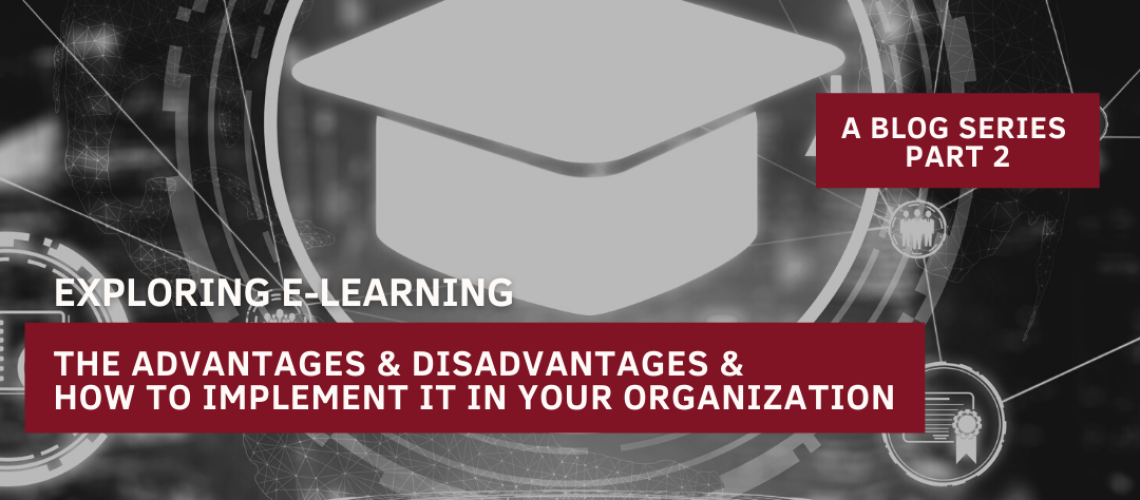By Dr. Salam Slim Saad
Welcome back to our ongoing exploration of the world of E-Learning! If you’re joining us for the first time, we recommend checking out previous article “E‐Learning: A Brief History, Future Trends, and Varied Learning Approaches” where we delved into the history of this fascinating field, discussed future trends, and examined various learning approaches that are currently shaping the digital education landscape.
In this second part of our E-Learning series, we’ll dive deeper into the heart of the matter: the benefits, the disadvantages, and crucially, how to effectively implement E-Learning within your organization. E-Learning isn’t just an ongoing trend or an educational experiment – it’s a transformative strategy with the potential to revolutionize how we think about knowledge, skills, and continuous professional development.
Like any tool, E-Learning has its pros and cons. Its advantages of flexibility and personalized learning pathways are impressive, but challenges such as self-discipline and technical issues can also arise.
Whether you’re an organizational leader, an educator, or a lifelong learner, join us as we navigate the intricacies of E-Learning, offering you the knowledge to transform the learning experience in your organization.
Let’s uncover the full spectrum of E-Learning together. Ready? Let’s dive in!
The Benefits of E-learning
With the advancement of technology and increasing accessibility to the internet, e-learning has transformed the way people learn and acquire new knowledge. E-learning, or electronic learning, offers several key benefits compared to traditional classroom-based education. Here are some of the significant advantages of e-learning:
- Flexibility and Convenience: E-learning provides learners with the flexibility to access educational materials and courses at their own pace and convenience. Students can study from anywhere, at any time, using a computer or mobile device with an internet connection. This flexibility is particularly beneficial for individuals who have work or family commitments, allowing them to balance their learning with other responsibilities.
- Accessibility and Inclusivity: E-learning makes education accessible to a wider audience, including individuals with physical disabilities, those living in remote areas, or people who cannot attend traditional classrooms due to various constraints. It eliminates geographical barriers and allows learners to access high-quality educational resources irrespective of their location.
- Personalized Learning Experience: E-learning platforms often use adaptive learning technologies, which tailor the content and pace of instruction to the individual needs and abilities of learners. This personalized approach ensures that students can learn at their own speed, focus on their areas of weakness, and skip material they have already mastered. It enhances engagement and learning outcomes by catering to diverse learning styles.
- Cost and Time Efficiency: E-learning eliminates the need for commuting, accommodation, and physical learning materials, resulting in significant cost savings for both learners and educational institutions. Additionally, e-learning programs typically have shorter course durations, as they can be designed to deliver the core content efficiently, without unnecessary delays or interruptions. This allows learners to acquire knowledge and skills more quickly.
- Variety of Learning Resources: E-learning offers a wide range of multimedia resources such as videos, interactive simulations, quizzes, and online forums. These resources enhance the learning experience by presenting information in engaging and interactive formats. Learners can access a variety of learning materials and explore different perspectives, leading to a more comprehensive understanding of the subject matter.
- Scalability and Consistency: E-learning allows educational institutions and organizations to scale their training programs efficiently. Once an e-learning course is developed, it can be easily replicated and delivered to a large number of learners simultaneously, without compromising the quality or consistency of the content. This scalability makes e-learning a cost-effective solution for educational institutions, businesses, and government agencies.
- Continuous Learning and Lifelong Education: E-learning encourages lifelong learning by providing opportunities for individuals to upskill and acquire new knowledge throughout their lives. It enables professionals to stay updated with the latest developments in their field, enhancing their employability and career prospects. E-learning platforms often offer a wide range of courses and certifications, catering to diverse interests and learning goals.
E-learning offers interactive features such as videos, quizzes, discussion forums that promote active participation and collaboration among learners worldwide.
Overall, e-learning offers flexibility, accessibility, personalization, cost efficiency, and a variety of resources, making it a powerful and effective approach to education and training in the digital age.
The Disadvantages of E-learning
While e-learning offers numerous advantages, it also has some disadvantages that are worth considering. Here are some of the main drawbacks associated with e-learning:
- Lack of face-to-face interaction: One of the primary disadvantages of e-learning is the absence of direct, in-person interaction with instructors and peers. This can hinder communication, collaboration, and the ability to ask questions and receive immediate feedback.
- Limited social interaction: E-learning often isolates learners from the social aspects of traditional classroom settings. There may be limited opportunities for networking, forming study groups, or engaging in spontaneous discussions with classmates, which can negatively impact social skills and the overall learning experience.
- Self-discipline and motivation: E-learning requires self-motivation and discipline since learners must manage their own time and pace of learning. Without the structure and accountability provided by regular classroom sessions, some individuals may struggle to stay focused and maintain a consistent learning schedule.
- Technological issues: Technical problems such as internet connectivity issues, software glitches, or hardware malfunctions can disrupt the learning process. Technical difficulties can be frustrating and may cause delays or even prevent access to course materials, lectures, or assessments.
- Limited hands-on experience: Some subjects, such as science labs, fine arts, or vocational skills, require hands-on experience and practical training. E-learning may struggle to provide the necessary resources or simulations to fully replicate these experiences, limiting the effectiveness of learning in certain fields.
- Accessibility challenges: E-learning heavily relies on technology and internet access. Not everyone has equal access to these resources due to financial constraints, geographic limitations, or infrastructure issues. This can create disparities in access to education, further exacerbating educational inequalities.
- Potential for distraction: Learning from home or other non-academic environments can lead to distractions that hinder concentration and focus. Factors like noise, family responsibilities, or personal obligations can disrupt the learning process and impact overall performance.
- Limited feedback and clarification: In a traditional classroom, students can easily seek clarification or ask questions in real-time. In an e-learning environment, obtaining immediate feedback or asking for further explanations may be more challenging, potentially slowing down the learning process.
It’s important to note that the significance of these disadvantages can vary depending on the learner’s preferences, the course content, and the quality of the e-learning platform or program being used. Additionally, advances in technology and instructional design may mitigate some of these limitations over time.
Despite these drawbacks, many organizations are finding ways to overcome these challenges and make e-learning a successful part of their training programs.
So don’t let these disadvantages discourage you from exploring the possibilities of transforming learning through e-learning!
How to Implement E-learning in Your Organization
Implementing e-learning in your organization can bring about a transformational shift in how learning is delivered and accessed. Here are some key steps to consider when implementing e-learning:
- Assess Your Organization’s Needs: Before diving into the world of e-learning, it’s important to understand what specific learning needs exist within your organization. Conduct a thorough assessment to identify gaps and areas where e-learning can be most beneficial.
- Set Clear Goals And Objectives: Once you have identified the learning needs, establish clear goals and objectives for your e-learning program. What do you want learners to achieve? How will you measure success?
- Choose The Right Platform: There are numerous e-learning platforms available, each with its own features and capabilities. Evaluate different options based on factors like ease of use, scalability, customization options, and integration with existing systems.
- Create Engaging Content: One of the advantages of e-learning is the ability to create interactive and multimedia-rich content that keeps learners engaged. Invest time in creating high-quality content that aligns with your learning objectives.
- Provide Ongoing Support: Implementing e-learning requires ongoing support for both learners and instructors/trainers. Ensure that there is a system in place for technical support, troubleshooting, and providing feedback or guidance as needed.
- Monitor Progress And Evaluate Effectiveness: Regularly track learner progress through assessments or quizzes built into the courses. Gather feedback from users to evaluate the effectiveness of the e-learning program and make necessary adjustments.
Remember that successful implementation of e-learning requires careful planning, collaboration among stakeholders, continuous evaluation, and adaptation to meet evolving organizational needs.
In conclusion, the future of learning lies in e-learning. Advances in technology will soon allow you to obtain knowledge and skills from the comfort of your own home, office or even while traveling. E-learning will help organizations save time and money and greatly improve employee retention by keeping them engaged through out the learning process online. The best part is that e-learning can be integrated with other business operations to bring even greater streamlining and efficiency to all processes, thus saving time, effort and money.
As we conclude this two-part series on e-learning, we hope that it has provided you with valuable insights into the world of online education. By harnessing the power of e-learning, we can unlock unlimited possibilities for learning and growth. Embrace this transformative approach and continue to explore the ever-expanding horizons of e-learning in your personal and professional life.
Written By:



